Educator exodus
8/31/2022As a new school year begins, education personnel remain in short supply, and schools across the nation are taking drastic measures. In Florida, veterans can teach up to five years without a teaching certificate. In Arizona, public schools may begin training teachers without a bachelor’s degree. In some districts, five-day school weeks have been shortened to four.
Iowa is no different when it comes to staffing shortages and teacher burnout. When did this problem originate, how are local schools dealing with it, and what needs to change?
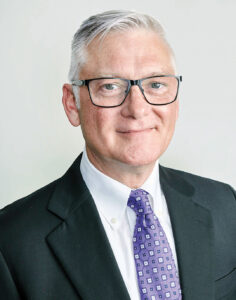
Mike Beranek is a third-grade teacher currently serving as president of the Iowa State Education Association. Photo courtesy of ISEA
A growing problem
Mike Beranek is a third-grade teacher who has taught for the West Des Moines Community School district for 34 years. In that time, he’s seen downward shifts in society reflected in classrooms.
“When I first started teaching, I was able to concentrate on the act of educating a child and helping them grow emotionally and socially,” he said. “However, as the years progressed, I saw that our schools were being required to do more and more for students.”
Currently on leave from his teaching job, Beranek is entering his fifth year as president of the Iowa State Education Association (ISEA), Iowa’s largest teacher’s union. In his travels across the state, he has witnessed schools working with populations that have greater needs than ever before. On top of education, schools are now tasked with addressing food insecurity, mental health crises and more.
“Education has become a 24-hours-a-day job, seven days a week,” said Beranek, deeming the increase in teachers’ workloads “exponential.”
As social issues bleed into classrooms, so do politics. While issues have been brewing for several years now, Beranek said the COVID pandemic brought many problems to the surface — and left even greater responsibilities at the feet of teachers. After the initial pandemic shutdowns of 2020, folks looked to reopening schools with a “fresh attitude,” Beranek said.
“Things were going to be different; everything was going to be positive — and it wasn’t.”
It’s a vicious cycle. Older educators are retiring earlier. Aspiring educators are rethinking their career choices. Current educators are scrambling to fill in the gaps in each school day. And as members of the public witness the increasing stresses placed on educators — and the subsequent exodus from the profession — fewer want to enter into it.
Earlier this year, survey results from the National Education Association revealed that 55% of responding educators were likely to leave or retire from education sooner than planned. Between the beginning of the pandemic and the end of last school year, the Bureau of Labor Statistics reported around 300,000 public school teachers and staff members leaving the field.
Perhaps the most visible barrier to educator retention is less-than-competitive compensation. In Iowa, the minimum base salary for a teacher is $33,500, last raised in 2016 from $28,000. In Des Moines last year, the average full-time teacher’s salary hovered around $58,000, according to a report from the Iowa Department of Education.
“That is not competitive compared to other degreed professions that require the same amount of education,” Beranek said.
At press time, upwards of 5,000 staff vacancies were listed on Teach Iowa, a statewide job board provided by the Iowa Department of Education.
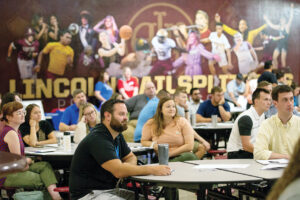
Teachers at Des Moines Public Schools attend orientation on Aug. 11. Photo courtesy of Des Moines Public Schools
Increasing incentives
As alternative professions with bigger salaries and smaller workloads lure away teachers, schools have been trying to combat the staff exodus with incentives.
In August, Des Moines Public Schools (DMPS) offered a $50,000 bonus to certain staff members near retirement age if they remained for the 2022-2023 school year. In June, the district announced plans to offer full benefits to part-time employees. Returning staff who committed to staying with the district for the 2022-2023 school year were offered an incentive of $1,250. Special education teachers received a hiring bonus of $3,000, and bus drivers up to $5,000.
The largest district in the metro, DMPS serves a population of about 30,000 students across 38 elementary schools, 11 middle schools, five high schools and 10 special schools and programs. Of the approximately 4,800 employees needed for the district to operate, about 320 resigned or retired at the end of last school year. During the past decade, that annual number typically fell around 200, said district spokesperson Phil Roeder.
School support staff provide vital services outside of the classroom: transportation, meals, student supervision, clerical duties, facility management, school safety, 1:1 student support and more. At press time, the DMPS employment website was still seeking to fill 87 of those positions.
Persisting staff vacancies among Metro Kids Care prompted the district to put its after-school program on hold at three of its elementary schools.
“Otherwise, we’re not planning to change any services such as transportation or meals provided to our kids,” Roeder said.
Among school extracurriculars, openings for supplemental positions — typically taken on by existing school staff — were sitting at 65 openings. Among certified staff, DMPS’ greatest hiring needs have been for middle school classroom teachers and elementary special education teachers. Licensed and certified staff vacancies were sitting at 55 at press time.
During a school year that begins with remaining vacancies, teachers may be reassigned to different buildings and classes, Roeder said. Schools may also handle vacancies through long-term substitute teachers, which maintains consistency for students. The district recently increased the daily pay for long-term substitutes from $150 to $180.
“The fallout from COVID and the ‘Great Resignation,’ along with the nation being at near full-employment, has impacted every employer, including education, and it’s no different in Iowa in the challenges in hiring staff,” Roeder said. “We still have work to do to be 100% fully staffed, but the needle has moved in the right direction over the past few weeks.”
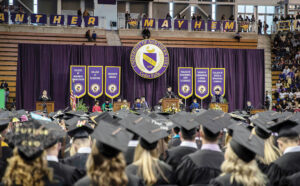
Hundreds of Iowa educators graduate from the University of Northern Iowa each year. Photo courtesy of UNI
Pumping up the pipelines
Not only are more teachers leaving; fewer are coming. Formerly known as the Iowa State Teachers College, the University of Northern Iowa (UNI) has long been the alma mater of many educators in the state. Yet, enrollment in UNI’s College of Education (COE) is down. One decade ago, the number of COE bachelor’s degrees granted consistently hovered in the mid-500s. Only 470 such degrees were granted in the 2021-2022 school year. In the fall 2011 semester, UNI’s COE saw a total enrollment of 2,367 — 542 of which were new students. Ten years later, those numbers had dwindled to 1,779 total, with 388 new students.
As careers in education have lost their appeal, governments have worked to remove barriers and bolster teacher pipelines. In Iowa, those with as few as 60 college credits may apply to serve as a substitute teacher. Over the summer, Gov. Reynolds announced funding for an apprenticeship program allowing high school students and adult paraeducators to earn teaching credentials while working in a classroom. And the recently passed HF 2081 eliminated the PRAXIS, an exam teachers were formerly required to take between college graduation and certification.
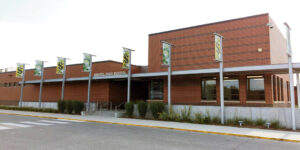
Saydel Community School District is led by Superintendent Todd Martin and includes Cornell Elementary, Woodside Middle School and Saydel High School, pictured. Photo submitted
Smaller district, same shortage
Smaller school districts face the same issues as larger districts. However, they possess fewer puzzle pieces to adjust to make insufficient staff numbers work, said Saydel Superintendent Todd Martin.
Last year, Saydel High School closed for a day after 16 staff members were unable to work. District leadership decided there simply wasn’t enough staff to safely operate.
Along the same lines as Beranek, Martin said COVID was simply a trigger, illuminating core issues that had built up from years of increased mental health problems and stressors, particularly in at-risk environments.
“In knowing that, we’ve increased our structures and resources around counseling services, social workers, education surrounding mental health, and are working diligently to continue to grow impactful programs,” Martin said. “But we are being outpaced by the need.”
Saydel serves about 1,200 students across three schools. When it comes to hiring, Martin emphasized the importance of all districts working together as they vie for limited resources.
“I don’t believe schools should compete with one another,” he said. “At a certain point — and I’ve seen this start to happen — are we stealing people or resources, or poaching or luring away contracted teachers after contracts are due? That’s a dangerous slippery slope. I want to help kids not just in my district, which is my primary focus, but also in other districts.
“There’s a fine line in how we create neighborly boundaries to ensure we’re not hurting other districts and, ultimately, kids in that way.”
Last school year, six teachers left the Saydel school district mid-year, with a total of 29 teacher vacancies to fill for the 2022-2023 year. At press time, all staff positions had been filled.

Casey Jacobson graduated from the University of Northern Iowa and taught for four years, including two years at Saydel High School, before “burning out of the profession.” Photo submitted
Former teacher speaks on burnout
One of the 29 who left Saydel last year was Casey Jacobson. Following in the footsteps of her grandmother, who taught for five decades, Jacobson said she’d really started to “fall in love with the profession.”
After teaching at a Catholic private school for two years, Jacobson came to Saydel in 2019, just in time for the COVID-19 pandemic. By the 2020-2021 year, teachers were not only expected to livestream their classes but also pre-record and upload lessons in advance.
“It was like doing double the work,” she said.
With frequent staffing shortages, Jacobson often found herself subbing during her planning periods. On multiple occasions, she integrated an absent teacher’s class into her own.
“They would just sit and work on stuff they needed to work on, but let’s be real, they would sit and be on their phone or listen to music,” she said. “It was just us getting by at that point.”
Two months into her fourth year of teaching, Jacobson began to consider leaving the profession. By February, she had made up her mind. Her reasons were numerous, but typical for many teachers: overwork, under-compensation, disrespect and feeling like a “political pawn.”
“I feel like the education system just chewed me up and spit me out, as a very self-deprecating person,” she said. “I think one of the biggest gripes of teachers is how undermined and micromanaged they feel by administration, by parents, by even kids sometimes.”
Jacobson now works as an administrative assistant for an engineering firm and no longer comes home “exhausted” at the day’s end. She said the career switch has improved her physical and mental health, as well as her relationships with others. At her teaching job, she estimated working 60 hours per week. Now, she works 40 hours per week and makes an additional $600 each month, on average.
Will Jacobson ever return to the profession? It’s a big question, one she doesn’t have an answer for. Many things would have to change before she considered it.
“I feel like we’re in this weird spot in education right now where it’s all content, content, content,” she said. “Learning must be happening at all times, every second of every day of every class.”
Of course, it’s a given: teachers believe in the importance of learning. But, Jacobson said, it’s also important for the school day to allow room for relationships.
“I think that seeing your teacher as a human and seeing your students as humans — it just makes teaching and learning easier.”
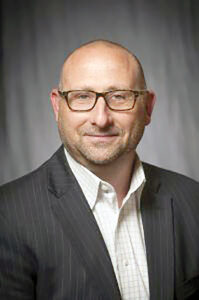
Cade Lambert serves as head of school at Des Moines Christian School. Photo submitted
A private school’s perspective
Teachers, and former teachers like Jacobson, frequently cite a lack of support and an excess of micromanagement as reasons for burnout. Private institutions often offer teachers more flexibility than public schools, according to Cade Lambert, head of school at Des Moines Christian School (DMCS) in Urbandale.
“We put a lot of trust in our employees to work the hours they need to get the job done at a high level, so we don’t really fuss about the contract day or things like that, unless we have to.” Lambert said. “We try to provide our employees with as much choice and professional discernment as possible.”
Lambert spent four years teaching in public school classrooms in Perry and Urbandale before transitioning into the realm of private education. On average, private school teachers make between $10,000 and $15,000 less than their public-school counterparts, the National Center for Education Statistics (NCES) found. Even in 2017, well before the pandemic, NCES reported that private schools have higher teacher turnover rates than public schools.
And yet, Lambert said DMCS hasn’t been affected by the high resignation numbers that many other schools have experienced.
One reason for this, Lambert suggested: many, although not all, private schools are faith-based and mission-focused. Their employees share that mission, and parents and students often do, as well.
Local private schools have certainly not been immune to staffing shortages. Like most schools, DMCS has struggled to find bus drivers and substitute teachers. According to Lambert, employment applications for teachers, coaches and administration positions have decreased in number.
Regarding future educator pipelines, Lambert said he thought private schools had more leverage to innovate teacher training and certification, citing alternatives like on-the-job training or teacher colleges.
“If we can’t find a mechanism to pay them more, we can’t continue to ask them to go and get four years of schooling and take on $60,000 of debt. Because the math doesn’t work,” he said. n
Changing the narrative
So, what is the first thing that needs to change? Ask most any educator — former or current, superintendent or associate — and you’ll probably receive the same answer. It starts with each individual’s attitude toward education.
“The level of disrespect right now that’s occurring all across Iowa and the country needs to stop,” Beranek said, pointing out the growing minority voice that questions the professionalism and decision-making ability of educators.
“The majority of Iowans need to start to speak up and drown out that voice,” he added. Practically, Beranek suggested speaking to school boards to voice satisfaction in specific teachers, doing the same at civic and other community groups, and, overall, ensuring that educators feel welcome and valued.
“I think we need to reset culturally to understand that the overwhelming majority of teachers are in this profession because they want to impact kids,” Lambert said. “We’ve got to bring some honor back into the profession and respect the work that’s done there. Because it’s really important work. We need both great public schools and great private schools — and in order to have those, we need to keep people that are soft-hearted and in it for the right reasons.” ♦





















